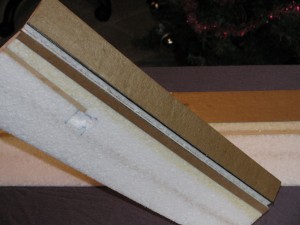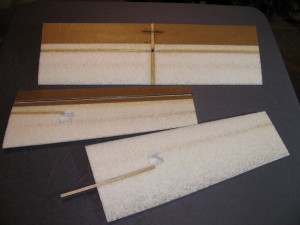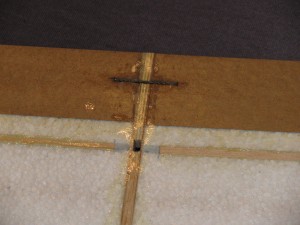It’s driving me buggy, but I’m getting it done. Slowly but surely I’m amassing the information I need to be able to lead a customer through the process of building an aileron Push-E Cat.
If it was just me slapping some one-off together for a weekend fly-in, that’s one thing. When you’re putting something together that you want to impress people enough that they want to have one of their own, well, you tend to try and do better – at least I do.
And I suppose that’s a goal I should express. I know that anything I put together in my ad hoc shop isn’t going to look like the mass-produced stuff coming out of Tower Hobbies or Sky King or whatever. Heck, I don’t do ARFs to begin with. Still, when a customer gets one of my kits and opens it up, I want to do my best to make sure that they’re happy with the amount of effort I put into making it the best I could.
In short, I want to maintain the engineering rep I built up with my earlier work.
That’s the long and short of why I’m working my way through this aileron wing while bouncing back and forth between the shop and my CAD tube. I could just sit here and wave my hands and pretend to know what I’m talking about when I tell people how to install their servos, cut live hinges, install the kraft paper, and route the wire channels – but I won’t.
But, you know, having said that, I think I need to mention that people who are willing to offer suggestions and feedback are the core of making a product better. Not that every suggestion is something that can be integrated into a production kit – some goals or ideas are just too specific or eclectic or some techniques not exactly right for a particular airframe. Still, lots of ideas and thoughts have driven the Push-E Cat to evolve and similar things will push other project forward.
For example, I saw a blog post about E-200 pylon racing in Utah on RC Groups the other day. I immediately pulled up the wing planform for the Manx and Hot Cat and realized that all I had to do was add an inch to either wing panel and the designs would be legal. On top of that, by looking at the current planes on their web page, I realized that I had been over-thinking the motor installation revisions necessary to put brushless motors in the EPP airframes.
Another example are the hints, suggestions, and examples of modifications that people offer up on the Push-E Cat thread on RC Groups. I can’t express how great it is that there are folks (Hi, Bill!) willing to share their ideas and insights. I’m of the opinion that listening is one of the most important skills an engineer has. Another one is the ability to realize that their idea may not be the best one and be willing to change gears.
An example of this is the 2 mm coroplast tail on the V5. I’d given up on coroplast. I had convinced myself that the material had its uses but not in the ass-end of my aircraft. Yet, the people in the thread pointed out to me how 2 mm with carbon fiber reinforcement was still viable. I decided to try it and I’m glad I did because the new tail works great.
The Push-E Cat contains a lot of change. Denny innovated the laminated motor mount. I grabbed that idea and expanded on it for the V5. The dowel carrier assemblies came out of customer feedback about dowels ripping out of the EPP. The servo-block style mounting came from people complaining bout installing the servos buried in the middle of the fuselage. The V5 mounts its speed control in the main cabin and I’ve added flow-through cooling channels to facilitate that. Why? Because people don’t want to put their speed control on top of the wing. It used to make sense when we were using Jeti 10 compact speed controls and 6V Speed 400 motors. Now? Listen to the customer.
Other changes, like how I’m using the kraft paper and 3M 90 for the trailing edge are more production and engineering related. I’m fairly sure it’s going to work out great. Am I 100% sure? Oh, hell no. That’s why I’m slapping together an aileron wing while simultaneously trying to write the instructions for the kit. It’s probably going to cost me any Christmas shipping at this point but that’s just the way it is. If it doesn’t work, I’m back to balsa for the trailing edge and the instructions are completely different. I’ve got to know now.
Then again, I may not be 100% sure, but I’m still pretty doggone sure. The addition of the 1/16″ rod to the aileron and the sub-trailing edge really add a lot and the wing hasn’t even been covered yet. Once you iron on the Ultracote, I think the structure is going to be awesome. On top of that, the live hinge is sweet. Just say no to tape hinges. I kind of like that.
Speaking of Ultracote, I suspect given the information from the Rite-wing thread, that if you use 3M 90 as the foam-prep before taping or covering, it probably doesn’t matter what covering you use (so long as it’s decent quality.) I’ll continue to use Ultracote because I’m used to it. However, the broader color range and easier availability of Monokote kind of makes me want to do some tests. Monokote is pretty strong linearly, unlike some other more “gooey” coverings. It’s more brittle than Ultracote, though, and goes on at a higher temperature IIRC. That might make it hard on thin trailing edges like the V5 features.
Of course, that’s why we test.
That’s pretty much it for tonight. I’d post more of the instruction pages, but they’re all text at this point. I’m up to doing the bill of material complete with graphics and the graphics bit requires me to do some actual solid modeling. Ergo, I’m banging my head against the CAD tube again. Should have some nice pages to share here tomorrow.





